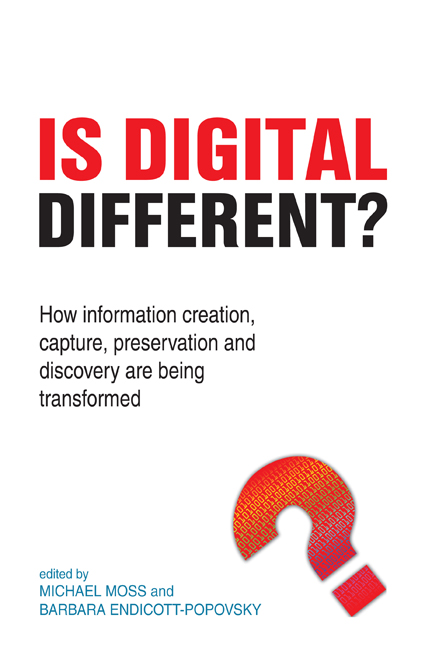 Is Digital Different?
Is Digital Different? Book contents
- Frontmatter
- Contents
- Contributors
- Introduction and acknowledgements
- 1 What is the same and what is different
- 2 Finding stuff
- 3 RDF, the Semantic Web, Jordan, Jordan and Jordan
- 4 Crowdsourcing
- 5 Pathways to integrating technical, legal and economic considerations in the design, development and deployment of trusted IM systems
- 6 Finding archived records in a digital age
- 7 Security: managing online risk
- 8 Rights and the commons: navigating the boundary between public and private knowledge spaces
- 9 From the Library of Alexandria to the Google Campus: has the digital changed the way we do research?
- Index
6 - Finding archived records in a digital age
Published online by Cambridge University Press: 08 June 2018
- Frontmatter
- Contents
- Contributors
- Introduction and acknowledgements
- 1 What is the same and what is different
- 2 Finding stuff
- 3 RDF, the Semantic Web, Jordan, Jordan and Jordan
- 4 Crowdsourcing
- 5 Pathways to integrating technical, legal and economic considerations in the design, development and deployment of trusted IM systems
- 6 Finding archived records in a digital age
- 7 Security: managing online risk
- 8 Rights and the commons: navigating the boundary between public and private knowledge spaces
- 9 From the Library of Alexandria to the Google Campus: has the digital changed the way we do research?
- Index
Summary
Introduction
For an archive to be of real value, simply gathering and preserving records will never be sufficient; nor should it be. The ability for a user to find the records that answer their information needs must always accompany the task of keeping. Furthermore, presenting records in a way that allows understanding about the context of their creation is and remains essential to enabling users to interpret records and give them meaning. Preservation and findability truly go hand in hand – what real value does an archival collection have if it cannot be effectively used and interpreted?
This, in itself, is not a new challenge; the abstract problem of finding and understanding relevant records in a collection is as old as collections of records themselves. At The (UK) National Archives in London there are examples of ‘finding aids’ going back over 500 years, including one from 1575 which offers an early form of guidance on how to use complex Chancery records.
The National Archives’ catalogue had its genesis over 150 years ago in the annual reports that the Keeper of the Public Records provided to Parliament. These reports, beginning from the time that The National Archives (then known as the Public Record Office) was founded, quickly became the mechanism by which records could be found. Building on that legacy, generations of archivists developed a comprehensive printed catalogue with associated authority files and other finding aids.
As early as the 1980s computers began to be used to help archivists manage and structure the catalogue of hundreds of thousands of entries and produce it in paper form. These paper lists then became the basis for an electronic catalogue system used by National Archives staff to manage the collection. In April 2001, the first iteration of this electronic catalogue was made available online, revolutionizing the way users find records in the Archives. Since its release, The National Archives’ catalogue has continued to grow and evolve as technology, the nature of the collection and users’ needs and expectations have changed. It now holds many million entries, with more and more being added every week.
- Type
- Chapter
- Information
- Is Digital Different?How information creation, capture, preservation and discovery are being transformed, pp. 129 - 148Publisher: FacetPrint publication year: 2015


